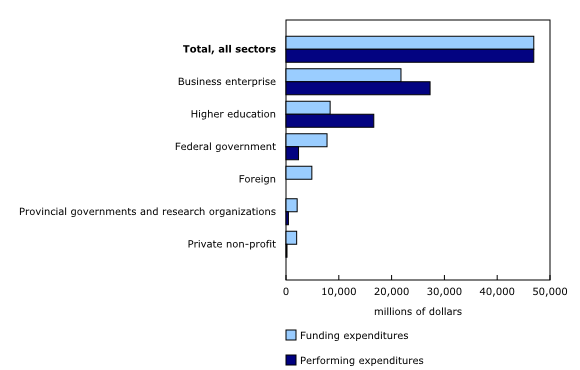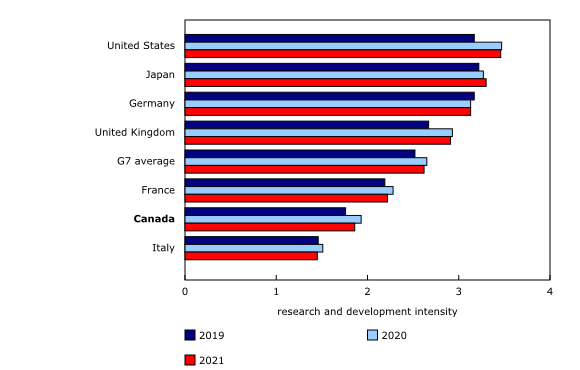Gross domestic expenditures on research and development, 2021 (final), 2022 (preliminary) and 2023 (intentions)
Released: 2023-12-22
$46.9 billion
2021
9.3% 
(year-over-year change)
Gross domestic expenditures on research and development (GERD) represent a country's overall investment in research and development (R&D). The importance of R&D comes from the creation of new knowledge that can result in tangible outcomes, such as the production of new products, services and processes. R&D also enhances human capital, which represents the experience, knowledge, skills and education of the workforce. The enhancement of human capital, along with product, service and process innovation, can in turn increase productivity, thereby affecting firm competitiveness and economic growth needed to sustain and grow the population's quality of life.
Canada sees record-strong growth in research and development spending in 2021
In 2021, overall R&D expenditures reached $46.9 billion, up $4.0 billion (+9.3%) from 2020. This increase marks the largest growth in year-over-year spending that Canada has seen. More than 90% of the expenditures occurred within four provinces: Ontario (+$1.7 billion to $21.5 billion), Quebec (+$849.0 million to $11.6 billion), British Columbia (+$595.0 million to $6.0 billion) and Alberta (+$553.0 million to $4.3 billion).
Early estimates show that national R&D expenditures increased in 2022, albeit at a slower pace, to $48.2 billion (+$1.2 billion). The business enterprise sector will have driven this growth. In 2023, spending is anticipated to increase to $49.1 billion (+$994.0 million).
Spending rises across most funding sectors
The business enterprise sector had the largest effect on R&D spending in 2021, with spending rising $2.6 billion to $21.8 billion. This sector's effect on overall spending was heightened because of its weight (46.4%) when compared with other sectors.
The growth in business R&D spending was mainly attributable to higher spending on software (+59.5%), reflecting the use of digital tools for R&D. This growth may have been accelerated by lockdowns in 2021 to reduce the spread of COVID-19.
The foreign sector, the second-largest contributing sector, rebounded from a slight decline in 2020 (-$30.0 million) to an increase of $762.0 million to $4.9 billion in 2021. Additional sectors that also saw growth included higher education (+$459.0 million to $8.4 billion) and private non-profit (+$410.0 million to $2.0 billion).
Following a year of record-level R&D funding, the federal government decreased its spending by $554.0 million to $7.8 billion in 2021. This decline was a result of decreased intramural (in-house) spending.
Businesses and higher education institutions are key research and development performers
In terms of performing R&D, which refers to the actual R&D work carried out, growth in 2021 was mainly attributable to the business enterprise sector (+$3.6 billion to $27.3 billion) and the higher education sector (+$715.0 million to $16.6 billion). Together, these sectors accounted for 93.6% of R&D performed in 2021.
Offsetting this increase was a decrease in R&D performed by the federal government (-$406.0 million to $2.4 billion).
Research and development spending by type of science
R&D spending can be broadly categorized into the natural and social sciences. In 2021, spending in the natural sciences and engineering category increased $3.9 billion to $42.5 billion. This is the largest percentage increase in this category since 2001 and is mainly due to increased spending by the business enterprise sector.
R&D spending in the social sciences, humanities and the arts rose $92.0 million to $4.4 billion in 2021. This rise was the result of additional spending by the higher education sector, which accounted for 61.6% of total social sciences spending.
Spotlight: Canada and the world
Canada's R&D intensity (the nominal share of gross R&D expenditures as a percentage of gross domestic product [GDP]) decreased to 1.86 in 2021, down from the 1.93 ratio recorded in 2020 despite increased spending. This reflects the fact that, in 2021, the Canadian economy accelerated at a faster pace (GDP: +13.4% at current prices; +5.4% at 2017 constant prices) than R&D spending (GERD: +9.3% at current prices; +1.5% at 2017 constant prices).
Compared with other member countries, Canada continued to rank below the G7 (Group of Seven) average in 2021. Within the OECD, Canada fell two spots to 19th position.
Did you know we have a mobile app?
Get timely access to data right at your fingertips by downloading the StatsCAN app, available for free on the App Store and on Google Play.
Sustainable development goals
On January 1, 2016, the world officially began implementing the 2030 Agenda for Sustainable Development—the United Nations' transformative plan of action that addresses urgent global challenges over the next 15 years. The plan is based on 17 specific sustainable development goals.
Data on Canada's gross domestic expenditures on research and development are an example of how Statistics Canada supports the reporting on the global sustainable development goals. This release will be used to help measure the following goal:

Note to readers
This release presents gross domestic expenditures on research and development (GERD) for 2021 (final), actual gross preliminary data for 2022 and intentions data for 2023 at the national level. Provincial-level data are available only for 2021 and earlier years.
Data for GERD are available in current and constant dollars for both performing and funding sectors, by science type, province, territory and region in table 27-10-0273-01. Current dollars are used in this release's analysis.
There are six GERD performing sectors in Canada: business enterprise, private non-profit, higher education, federal government, provincial governments and provincial research organizations.
Research and development (R&D) funding comes from seven sectors: the federal government, provincial governments, business enterprises, higher education, private non-profit organizations, provincial research organizations, and the foreign sector.
GERD data presented in this release are performance-based and correspond to the sum of intramural R&D expenditures reported by performing sectors.
Funding sector data are derived from the source of funds indicated by the performing sectors. As a result, GERD-funding sector values will not equal funding data collected and released by individual sectors.
Provincial and territorial expenditures are assigned to the province or territory in which the performing organization is located. Provincial and territorial funding sector expenditures represent R&D funding distributed in a province or territory. The funds do not necessarily originate from within the province or territory.
The business enterprise data source for the GERD program was redesigned in 2014, including concepts and methodology. Users should therefore exercise caution when comparing data with historical datasets. To learn more about these survey changes, see the Annual Survey of Research and Development in Canadian Industry page on the Statistics Canada website.
The higher education data source was modified to include revised time-use coefficients in 2012. Users should exercise caution when comparing data with historical datasets.
Data for the provincial government performing sector are currently modelled and based on results from the 2011 Provincial Scientific Activities Survey. However, this release includes data on R&D activities performed by the provincial government of Quebec, which conducted its own survey and provided the information to Statistics Canada. Provincial research organization data are collected through a Statistics Canada survey.
References
Main Science and Technology Indicators (MSTI Database). (2023). On the left side of this page, under "Data by Theme," select "Science and Technology Indicators," then "Main Science and Technology Indicators (MSTI Database)" and search for "GERD as a percentage of GDP" from the drop-down list. (Accessed on December 20, 2023.)
Contact information
For more information, or to enquire about the concepts, methods or data quality of this release, contact us (toll-free 1-800-263-1136; 514-283-8300; infostats@statcan.gc.ca) or Media Relations (statcan.mediahotline-ligneinfomedias.statcan@statcan.gc.ca).
- Date modified:


